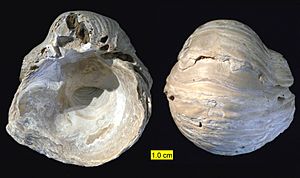Gryphaea facts for kids
Quick facts for kids Gryphaea |
|
|---|---|
 |
|
| Gryphaea sp. from the Cretaceous of Texas; left valve interior and exterior (same specimen) | |
| Scientific classification |
|
| Kingdom: | Animalia |
| Phylum: | Mollusca |
| Class: | Bivalvia |
| Order: | Ostreida |
| Family: | Gryphaeidae |
| Genus: | †Gryphaea Lamarck, 1801 |
Gryphaea (say "Griff-AY-uh") is a type of extinct oyster. People often call it the Devil's toenail because of its unique shape. These ancient oysters were once very common in the oceans.
You can find their fossils in many places. They are especially common along the Jurassic Coast in southern England. You can also find them in areas that were once part of the Sundance Sea in the United States. Gryphaea was a marine animal, meaning it lived in the sea. It was a bivalve, which means it had two shells. It belongs to the mollusc family called Gryphaeidae.
About the Devil's Toenail
Gryphaea oysters were most common during the Jurassic and Cretaceous periods. These periods were millions of years ago. They lived in huge groups, forming large "oyster beds." These beds were found in shallow, warm seas, often in muddy areas.
The Gryphaea genus lived for a very long time. However, they eventually died out. The last of them disappeared about 34 million years ago.
What Did They Look Like?
The shell of a Gryphaea oyster had two parts, called "valves." One valve was much larger and had a curved, lumpy shape. This is the part that looks like a "toenail." The other valve was smaller and flatter, like a "lid."
The soft body of the animal lived safely inside these two shells. This is similar to how modern oysters live today. If you look closely at the shells, you can see clear lines. These are called growth bands. They show how the oyster grew over time. The large, curved shell would sit in the mud at the bottom of the sea.
Where to Find Gryphaea Fossils
You can find Gryphaea fossils in several places around the world.
In England, they are often found along the coasts of Redcar and Weymouth. They are usually found in a type of clay called Kimmeridgian clay. In the United States, you can find them in riverbanks and cliffs. They are common in places like Texas and Kansas.
Often, these fossils get washed out of the clay. You can then find them on beaches or along riverbanks.
See also
 In Spanish: Gryphaea para niños
In Spanish: Gryphaea para niños

